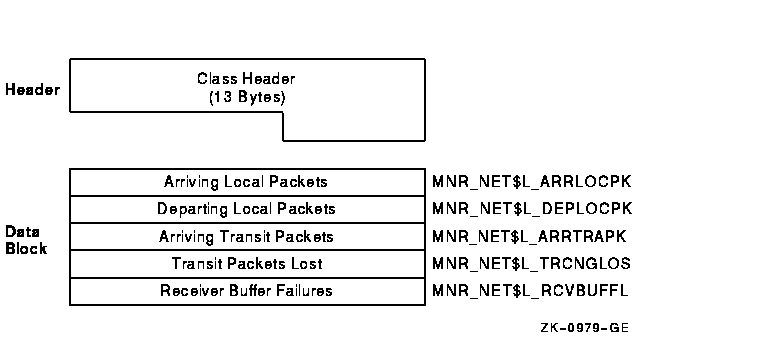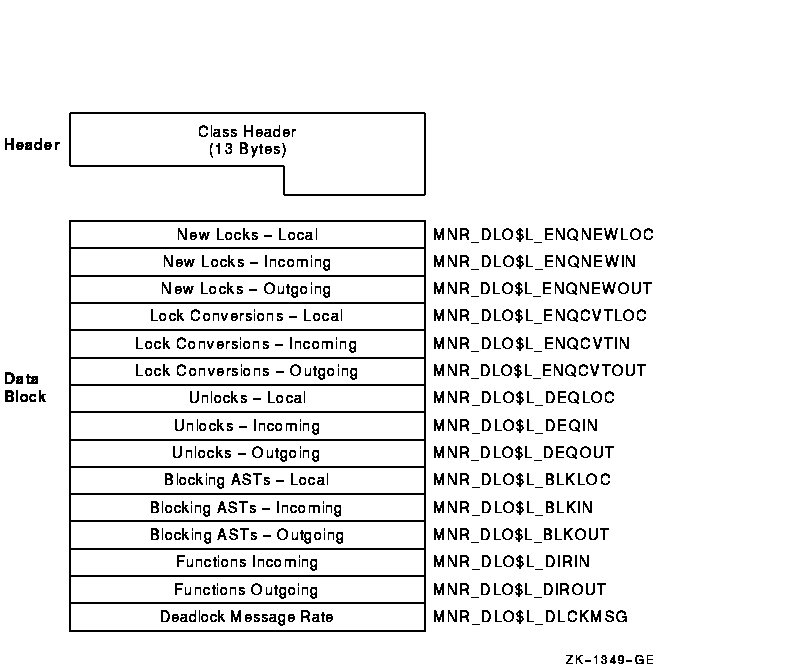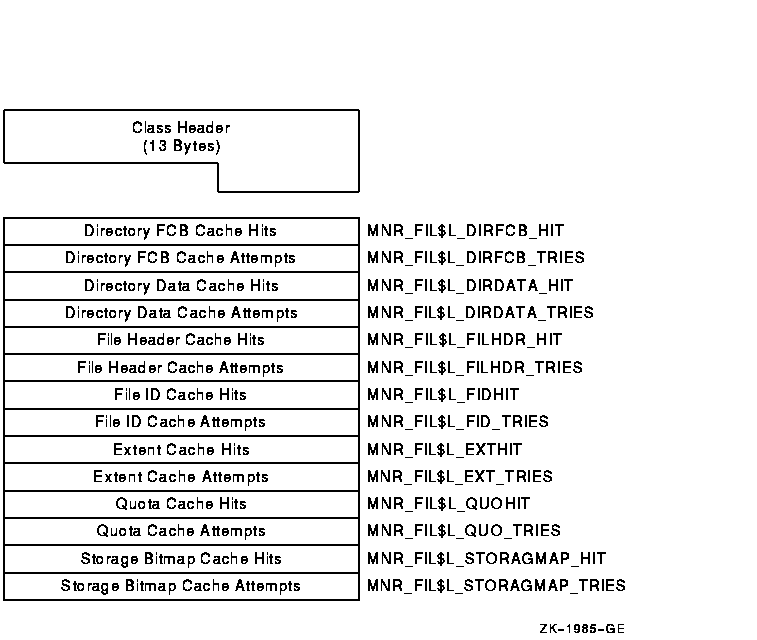| Previous | Contents | Index |
The class prefix always follows the class header for component class records. It contains data describing the number of elements (for example, processes for the PROCESSES class, disks for the DISK class) represented by the class records for the current collection interval. Unlike system class records, which have one data block per record, component classes have one data block per element.
One of the class prefix data items describes the number of elements (and therefore the number of data blocks) included in the class record. The other class prefix data item is used only for the PROCESSES class, and describes the number of processes included in the interval. The following discussion applies only to the PROCESSES class.
It is possible to monitor a number of processes so large that the required number of data blocks for one collection interval does not fit into a single maximum size record. In this case, the required number of PROCESSES class records is created to fully describe the processes.
All class headers in the set of PROCESSES class records for a given interval are identical, except for the setting of bit 0 in the MNR_CLS$W_FLAGS field. This bit is set to 1 for all records except the last, for which it is set to 0.
The class prefixes in the set of class records vary, as described in the table following the next figure. The contents of the MNR_CMP$L_ELTCT field depends on the number of data blocks contained in the record; the contents of the MNR_CMP$L_PCTINT field remain constant for each record in the set. All records in the set except the last contain as many data blocks as will fit into the maximum size record (32000 bytes). The last record in the set contains the remaining data blocks.
Figure H-7 illustrates the class prefix format.
Figure H-7 Class Prefix Format

The following table describes the fields in the class prefix. The class prefix is 8 bytes long.
| Field | Symbolic Offset | Contents |
|---|---|---|
|
Elements in
Record |
MNR_CMP$L_ELTCT | Count of elements (data blocks) in this record (1 longword). |
|
Processes in
Interval |
MNR_CMP$L_PCTINT | Count of processes (data blocks) for this interval (1 longword). This field is for the PROCESSES class only. For other component classes, this longword is reserved to HP for future use. |
The size and format of each data block and the number of blocks per record depend on the class. System classes have one data block per record. Component classes have one data block per element. The fields within each block are performance data items.
The following sections describe the data items within the data block for each class. Every data item falls into one of three categories. It is either a count, a level, or an informational item. A count is a numeric quantity that increases at each succeeding interval for the duration of a system boot. A level is a numeric quantity that may increase or decrease at each succeeding interval. An informational item represents data that, rather than being a unit of performance measurement (as are the first two types), is descriptive in nature.
In the tables that follow, item types are identified by the letters C
(count), L (level), and I (informational). Item types are shown in
parentheses, following the length of the field. Class records are
listed alphabetically.
H.4.2.1 CLUSTER Class Record
The CLUSTER class record contains data describing clusterwide CPU, memory, and locking activity. The CLUSTER class record has a record type of 19 and a size of 65 bytes. Note that when the CLUSTER class is recorded, the DISK and MODES classes are also recorded, even if not explicitly requested.
Figure H-8 illustrates the format of the CLUSTER class record.
Figure H-8 CLUSTER Class Record Format

The following table describes the fields in the data block for the CLUSTER class record:
| Field | Symbolic Offset | Contents |
|---|---|---|
| CPU Busy | MNR_CLU$L_CPU_BUSY | Count of clock ticks (10-millisecond units) spent in all CPU modes since system was booted (longword,C) |
| Free List Size | MNR_CLU$L_FRLIST | Number of pages currently on the free list (longword,L) |
| Reserved | MNR_CLU$L_RESERVED | Reserved to HP |
| Total Locks | MNR_CLU$L_TOTAL_LOCKS | Total of all incoming, outgoing, and local ENQs, DEQs, and conversions (longword,C) |
| New ENQ Local | MNR_CLU$L_ENQNEWLOC | Count of new lock requests that originate and are performed on the system (local) (longword,C) |
| New ENQ Incoming | MNR_CLU$L_ENQNEWIN | Count of new lock requests that originate on other systems and are performed on this system (incoming) (longword,C) |
| New ENQ Outgoing | MNR_CLU$L_ENQNEWOUT | Count of new lock requests that originate on this system and are performed on other systems (outgoing) (longword,C) |
| ENQ Conversions Local | MNR_CLU$L_ENQCVTLOC | Count of lock conversion requests (local) (longword,C) |
| ENQ Conversions Incoming | MNR_CLU$L_ENQCVTIN | Count of lock conversion requests (incoming) (longword,C) |
| ENQ Conversions Outgoing | MNR_CLU$L_ENQCVTOUT | Count of lock conversion requests (outgoing) (longword,C) |
| DEQ Local | MNR_CLU$L_DEQLOC | Count of unlock requests (local) (longword,C) |
| DEQ Incoming | MNR_CLU$L_DEQIN | Count of unlock requests (incoming) (longword,C) |
| DEQ Outgoing | MNR_CLU$L_DEQOUT | Count of unlock requests (outgoing) (longword,C) |
The DECNET class record contains data describing the operation of the DECnet for OpenVMS subsystem. The DECNET class record has a record type of 8 and a size of 36 bytes.
Figure H-9 illustrates the format of the DECNET class record.
Figure H-9 DECNET Class Record Format

The following table describes the fields in the data block for the DECNET class record:
| Field | Symbolic Offset | Contents |
|---|---|---|
|
Arriving
Local Packets |
MNR_NET$L_ARRLOCPK | Count of arriving local packets (longword,C) |
|
Departing
Local Packets |
MNR_NET$L_DEPLOCPK | Count of departing local packets (longword,C) |
|
Arriving Transit
Packets |
MNR_NET$L_ARRTRAPK | Count of arriving transit packets (longword,C) |
|
Transit Packets
Lost |
MNR_NET$L_TRCNGLOS | Count of packets lost because of transit congestion (longword,C) |
|
Receiver Buffer
Failures |
MNR_NET$L_RCVBUFFL | Count of receiver buffer failures (longword,C) |
The DISK class record contains data describing all disk devices in the system. The DISK class record has a record type of 12; its size depends on the number of disks being monitored. The size, in bytes, is calculated by adding the size of the class header, the class prefix, and the data blocks contained in the record. This is shown in the following formula:
16 + 8 + (44 * the value of MNR_CMP$L_ELTCT) |
Figure H-10 illustrates the format of the DISK class record on Alpha and Integrity servers.
Figure H-10 DISK Class Record Format - Alpha and Integrity servers

The following table describes the fields in the data block for the DISK class record:
| Field | Symbolic Offset | Contents |
|---|---|---|
| Allocation Class | MNR_DSK$W_ALLOCLS | Allocation class number (word,I) |
| Controller | MNR_DSK$T_CTRLR | Name of device controller (counted ASCII string) (4 bytes,I) |
| Unit Number | MNR_DSK$W_UNITNO | Unit number (word,I) |
| Flags | MNR_DSK$B_FLAGS | Total of 8 flag bits; if the low bit is set, the device is served by the MSCP server (byte,I) |
| Spare | MNR_DSK$L_SPARE1 | Reserved for future use |
| Node Name | MNR_DSK$T_NODENAME | Name of cluster node where device resides (counted ASCII string) (8 bytes,I) |
| Volume Name | MNR_DSK$T_VOLNAME | Volume name of disk (ASCII) (12 bytes,I) |
| Operations | MNR_DSK$L_OPCNT | Count of I/O operations (longword,C) |
| Queue Length | MNR_DSK$L_IOQUELN | Sum of I/O request queue samples (longword,C) |
The DLOCK class record contains data describing the operation of the Distributed Lock Management facility. The DLOCK class record has a record type of 14 and a size of 76 bytes.
Figure H-11 illustrates the format of the DLOCK class record.
Figure H-11 DLOCK Class Record Format

The following table describes the fields in the data block for the DLOCK class record:
| Field | Symbolic Offset | Contents |
|---|---|---|
|
New Locks
---Local |
MNR_DLO$L_ENQNEWLOC | Count of new lock requests that originate and are performed on this system (local) (longword,C) |
|
New Locks
---Incoming |
MNR_DLO$L_ENQNEWIN | Count of new lock requests originating on another system and performed on this system (incoming) (longword,C) |
|
New Locks
---Outgoing |
MNR_DLO$L_ENQNEWOUT | Count of new lock requests originating on this system and performed on another system (outgoing) (longword,C) |
|
Lock Conversions
---Local |
MNR_DLO$L_ENQCVTLOC | Count of lock conversion requests (local) (longword,C) |
|
Lock Conversions
---Incoming |
MNR_DLO$L_ENQCVTIN | Count of lock conversion requests (incoming) (longword,C) |
|
Lock Conversions
---Outgoing |
MNR_DLO$L_ENQCVTOUT | Count of lock conversion requests (outgoing) (longword,C) |
| Unlocks---Local | MNR_DLO$L_DEQLOC | Count of unlock requests (local) (longword,C) |
| Unlocks---Incoming | MNR_DLO$L_DEQIN | Count of unlock requests (incoming) (longword,C) |
| Unlocks---Outgoing | MNR_DLO$L_DEQOUT | Count of unlock requests (outgoing) (longword,C) |
|
Blocking ASTs
---Local |
MNR_DLO$L_BLKLOC | Count of lock manager blocking ASTs (local) (longword,C) |
|
Blocking ASTs
---Incoming |
MNR_DLO$L_BLKIN | Count of lock manager blocking ASTs (incoming) (longword,C) |
|
Blocking ASTs
---Outgoing |
MNR_DLO$L_BLKOUT | Count of lock manager blocking ASTs (outgoing) (longword,C) |
|
Directory Functions
---Incoming |
MNR_DLO$L_DIRIN | Count of directory functions (incoming) (longword,C) |
|
Directory Functions
---Outgoing |
MNR_DLO$L_DIROUT | Count of directory functions (outgoing) (longword,C) |
|
Deadlock
Message Rate |
MNR_DLO$L_DLCKMSG | Count of incoming and outgoing lock manager messages required for deadlock detection (longword,C) |
The FCP class record contains data describing the operation of the file system ACPs. The FCP class record has a record type of 5 and a size of 64 bytes.
Figure H-12 illustrates the format of the FCP class record.
Figure H-12 FCP Class Record Format

The following table describes the fields in the data block for the FCP class record:
| Field | Symbolic Offset | Contents |
|---|---|---|
| FCP Calls | MNR_FCP$L_FCPCALLS | Count of QIO requests received by the file system (longword,C) |
| Disk Allocations | MNR_FCP$L_ALLOC | Count of QIO requests that caused allocation of disk space (longword,C) |
| New Files | MNR_FCP$L_FCPCREATE | Count of new files created (longword,C) |
| Read I/Os | MNR_FCP$L_FCPREAD | Count of read I/O operations from the disk by the file system (longword,C) |
| Write I/Os | MNR_FCP$L_FCPWRITE | Count of write I/O operations to disk by the file system (longword,C) |
| Volume Lock Waits | MNR_FCP$L_VOLWAIT | Number of times a wait state was entered by the XQP due to volume lock contention (longword,C) |
| CPU Time | MNR_FCP$L_FCPCPU | Count of clock ticks (10-millisecond units) of CPU time used by the file system (longword,C) |
| FCP Page Faults | MNR_FCP$L_FCPFAULT | Count of page faults for the file system (longword,C) |
| Window Turns | MNR_FCP$L_FCPTURN | Count of file-map window misses (longword,C) |
| Access | MNR_FCP$L_ACCESS | Count of file name lookup operations in file directories (longword,C) |
| Files Opened | MNR_FCP$L_OPENS | Count of files opened (longword,C) |
|
Erase I/O
Operations |
MNR_FCP$L_ERASE | Count of erase I/O operations issued (longword,C) |
The FILE_SYSTEM_CACHE class record contains data describing the operation of the caches for the file system ACPs and XQPs. The FILE_SYSTEM_CACHE class record has a record type of 11 and a size of 72 bytes.
Figure H-13 illustrates the format of the FILE_SYSTEM_CACHE class record.
Figure H-13 FILE_SYSTEM_CACHE Class Record Format

The following table describes the fields in the data block for the FILE_SYSTEM_CACHE class record:
| Field | Symbolic Offset | Contents |
|---|---|---|
|
Directory FCB
Cache Hits |
MNR_FIL$L_DIRFCB_HIT | Count of hits on directory FCB cache (longword,C) |
|
Directory FCB
Cache Attempts |
MNR_FIL$L_DIRFCB_TRIES | Count of attempts on directory FCB cache (longword,C) |
|
Directory Data
Cache Hits |
MNR_FIL$L_DIRDATA_HIT | Count of hits on directory data cache (longword,C) |
|
Directory Data
Cache Attempts |
MNR_FIL$L_DIRDATA_TRIES | Count of attempts on directory data cache (longword,C) |
|
File Header
Cache Hits |
MNR_FIL$L_FILHDR_HIT | Count of hits on file header cache (longword,C) |
|
File Header
Cache Attempts |
MNR_FIL$L_FILHDR_TRIES | Count of attempts on file header cache (longword,C) |
|
File ID
Cache Hits |
MNR_FIL$L_FIDHIT | Count of hits on file ID cache (longword,C) |
|
File ID
Cache Attempts |
MNR_FIL$L_FID_TRIES | Count of attempts on file ID cache (longword,C) |
|
Extent Cache
Hits |
MNR_FIL$L_EXTHIT | Count of hits on extent cache (longword,C) |
|
Extent Cache
Attempts |
MNR_FIL$L_EXT_TRIES | Count of attempts on extent cache (longword,C) |
|
Quota Cache
Hits |
MNR_FIL$L_QUOHIT | Count of hits on quota cache (longword,C) |
|
Quota Cache
Attempts |
MNR_FIL$L_QUO_TRIES | Count of attempts on quota cache (longword,C) |
|
Storage Bitmap
Cache Hits |
MNR_FIL$L_STORAGMAP_HIT | Count of hits on storage bitmap cache (longword,C) |
|
Storage Bitmap
Cache Attempts |
MNR_FIL$L_STORAGMAP_TRIES | Count of attempts on storage bitmap cache (longword,C) |
The I/O class record contains data describing the operation of the I/O subsystem. The I/O class record has a record type of 4 and a size of 72 bytes.
Figure H-14 illustrates the format of the I/O class record.
Figure H-14 I/O Class Record Format

The following table describes the fields in the data block for the I/O class record:
| Field | Symbolic Offset | Contents |
|---|---|---|
| Direct I/Os | MNR_IO$L_DIRIO | Count of direct I/O operations (longword,C) |
| Buffered I/Os | MNR_IO$L_BUFIO | Count of buffered I/O operations (longword,C) |
| Mailbox Writes | MNR_IO$L_MBWRITES | Count of write-to-mailbox requests (longword,C) |
| Split Transfers | MNR_IO$L_SPLTRANS | Count of split transfers (longword,C) |
|
Logical Name
Translations |
MNR_IO$L_LOGNAM | Count of logical name translations (longword,C) |
| Files Opened | MNR_IO$L_OPENS | Count of files opened (longword,C) |
| Page Faults | MNR_IO$L_FAULTS | Count of page faults for all working sets (longword,C) |
| Page Reads | MNR_IO$L_PREADS | Count of pages read from disk as a result of page faults (longword,C) |
| Page Read I/Os | MNR_IO$L_PREADIO | Count of read I/O operations from disk as a result of page faults (longword,C) |
| Page Writes | MNR_IO$L_PWRITES | Count of pages written to the page file (longword,C) |
| Page Write I/Os | MNR_IO$L_PWRITIO | Count of write I/O operations to the page file (longword,C) |
| Inswaps | MNR_IO$L_ISWPCNT | Count of working sets read into memory from the swap file (longword,C) |
| Free Page Count | MNR_IO$L_FREECNT | Number of pages currently on free-page list (longword,L) |
|
Modified Page
Count |
MNR_IO$L_MFYCNT | Number of pages currently on modified-page list (longword,L) |
| Previous | Next | Contents | Index |